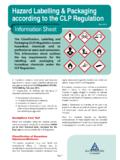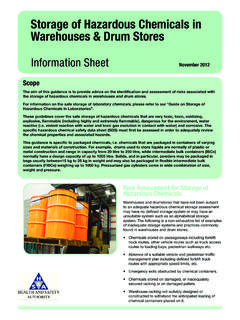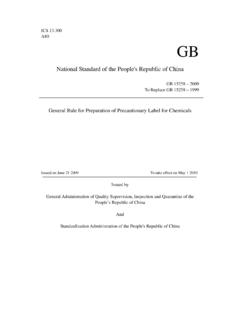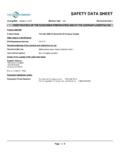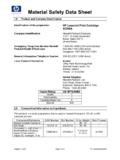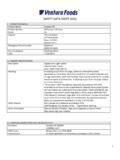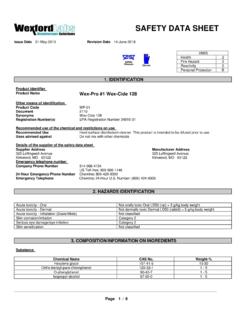Transcription of What’s new? Who is this guide for? What is the purpose of ...
1 Health and Safety Executive1 of 11 pagesCOSHH essentials: Controlling exposure to chemicals a simple control banding approachWhat s new?1 This guide has been updated to reflect changes under the classification, labelling and packaging (CLP) Who is this guide for?2 It is aimed at occupational hygienists and others who want to use the COSHH essentials control banding approach to identify suitable options for mitigating risks from substances hazardous to Paragraphs 34 61 are aimed at more specialist users, with a summary of the rules, conversion factors and default values used in COSHH is the purpose of this guide ?
2 4 This guidance describes how the COSHH essentials control banding was derived from a generic risk assessment scheme. A table in Appendix 1 lists the control guidance sheets that fall within each control approach (CA). These generic sheets contain basic descriptions of control equipment and good practice for a range of activities and also for some common operations (eg mixing, filling, weighing).5 Please note that the generic risk assessment applies to liquids and solids only; it does not apply to gases or to liquids used above their boiling This guide also explains the parameters, defaults and assumptions used in the COSHH essentials e-tool2 and its application to some common It does not cover the validation or development of COSHH essentials this can be found in other , 4, 5 The generic risk assessment scheme8 The generic risk assessment scheme was developed by a subgroup of HSE s former Advisory Committee on Toxic Substances (ACTS).
3 The scheme provides a practical route for selecting an appropriate generic control approach. It primarily involves: the allocation of substances to particular hazard groups, based on their toxicological classification and labelling under CLP; the anticipated exposures, based on: the physical properties of the substances; 1 of 23 pagesHealth and Safety Executive2 of 23 pagesCOSHH essentials: Controlling exposure to chemicals a simple control banding approach the amounts used; potential control options The generic risk assessment takes account of the chemical or product s health hazard classification and the exposure potential as illustrated in Figure 1 Factors used in risk assessment to identify appropriate control approach The health hazard is represented by the Hazard (H) statements assigned to substances during classification by suppliers under CLP.
4 The exposure potential is represented by physical properties of the substances (dustiness for solids, volatility for liquids) and the amount used in an operation or process. The generic risk assessment scheme (which is not intended for use as an exposure model) categorises substances into hazard groups and anticipated exposure ranges associated with the proposed use, for a range of different situations, to identify suitable control The generic risk assessment scheme is divided into four steps:Step 1 Group hazards that have adequate control at similar airborne concentrations, ie: identify the hazardous properties of the substances from labelling and safety data sheet information or other sources.
5 Place into a particular hazard group or band (seeTable 1). Step 2 Group the physical properties with amounts used to assign to exposure predictor bands with similar potentials for 3 Assess the anticipated exposure by applying each CA to each exposure predictor band, based on expert judgement (each CA gives an expected reduction in exposure).Step 4 Compare the predicted or anticipated exposure concentrations in air with the acceptable airborne concentrations outlined in Table 1, to help select a suitable control approach. Table 1 Allocation of H-statements to hazard groups and the associated airborne concentration ranges deemed to represent adequate groupTypeAcceptable concentration rangeUnitsH-statementsADust>1 to 10mg/m3H304, H315, H319, H336, EU66 Vapour>50 to 500ppmBDust> to 1mg/m3H302, H312, H332.
6 H371 Vapour>5 to 50ppmHEALTHHAZARDS ubstance allocated to aHazard Groupusing H-statementEXPOSUREPOTENTIALS ubstance allocated to adustiness orvolatility band anda band for thescale of useGENERIC RISKASSESSMENTC ombine healthhazard with exposurepotential factors todetermine the degreeof control neededCONTROLAPPROACHA pproach needed foradequate controlHealth and Safety Executive3 of 23 pagesCOSHH essentials: Controlling exposure to chemicals a simple control banding approachCDust> to , H311, H314, H317, H318, H331, H335, H370, H373, EU71 Vapour> to 5ppmDDust< , H310, H330, H351, H360, H361, H362, H372 Vapour< , H340, H341, H350, EU70 Vapour-ppmThe generic risk assessment scheme in further detailStep 1: grouping hazards11 Under CLP, the potentially adverse properties of a substance are represented by symbols and H-statements that appear on the label and in safety data sheets.
7 In COSHH essentials, the H-statements that represent toxicological hazards (ie threats to health) have been allocated to one of five groups, A to E. Appendix 3 lists all of the H-statements used in COSHH Groups A, B, C and D have each been assigned to, or relate to, a logarithmic airborne concentration range, for both dusts and for vapours. Table 1 shows these ranges and the grouping of H-statements. For the H-statements shown, the corresponding airborne concentration range is judged to represent adequate control within the COSHH essentials The upper boundary (the higher limit of Hazard Group A) represents levels that should not be exceeded (with the exception of occasional peak exposures for any substance), in accordance with good control This is 500 parts per million (ppm) for vapours and 10 milligrams per cubic metre (mg/m3)
8 For For some toxicological effects genetic damage and cancer arising from it, and respiratory sensitisation the available data and our current state of knowledge do not allow confident identification of exposure levels that present no significant risk. The H-statements relating to these hazardous properties have been assigned to Hazard Group E. For these substances, specialist advice should be sought and implemented on a case-by-case Group S skin and eye contact15 Some substances are of particular concern if they come into direct contact (in solid or liquid form) with the skin or eyes.
9 Hazard Group S signifies the importance of additional control measures for those substances whose H-statements denote: irritation, corrosivity or sensitisation arising from direct contact; the possibility of adverse effects inside the body resulting from absorption of substances through the skin after direct skin contact. 16 Additional control measures are listed in Appendix 1 as Control approach S, and focus on prevention of direct skin (or eye) contact. Further information on controlling skin exposure can be found on HSE s skin website: and Safety Executive4 of 23 pagesCOSHH essentials: Controlling exposure to chemicals a simple control banding approachStep 2: Grouping physical properties and amounts17 The determinants of exposure in COSHH essentials are physical property and amount in The physical property for solids is a subjective assessment of the material s dustiness.
10 Simple descriptors of dustiness put a substance into a high, medium or low dustiness The physical property for liquids is volatility at the process temperature. A chart relating boiling point to process temperature allocates a substance into a high, medium or low volatility The other determinant is the amount in use for the task. 21 Figure 2 describes these 2 Exposure potentialThe ACTS subgroup used professional judgement to allocate combinations of physical property and amount into one of four exposure predictor (EP) bands. These EP bands are shown in Table 2 Definitions of exposure predictor bands from amount and exposure potentialLow dustinessMedium dustinessHigh dustinessEP bandGramsGramsEP1 SolidKilograms and tonnesGramsEP2 SolidKilogramsKilogramsEP3 SolidTonnesTonnesEP4 SolidDeterminantLowMediumHighSolidDustin essPellet does not break upGranular orcrystallineFine solidand light powderLiquidVolatilityDeterminantSmallMe diumLargeAmountGramsKilogramsTonnesAmoun tMillilitresLitresCubic metresOperating temperature oCBoiling point of liquid oC3002502001501002550










